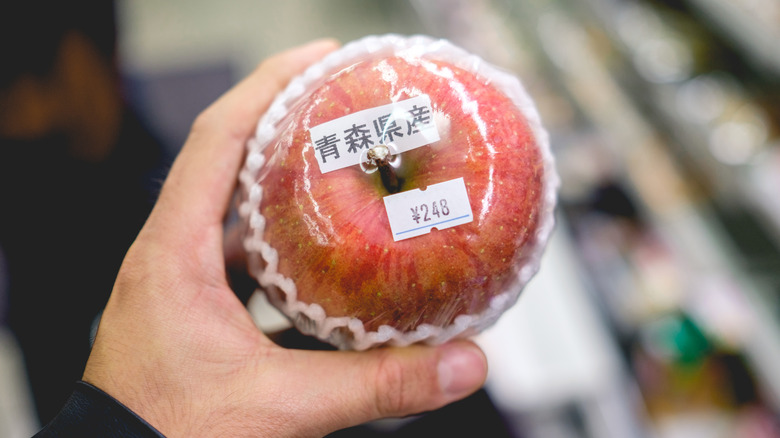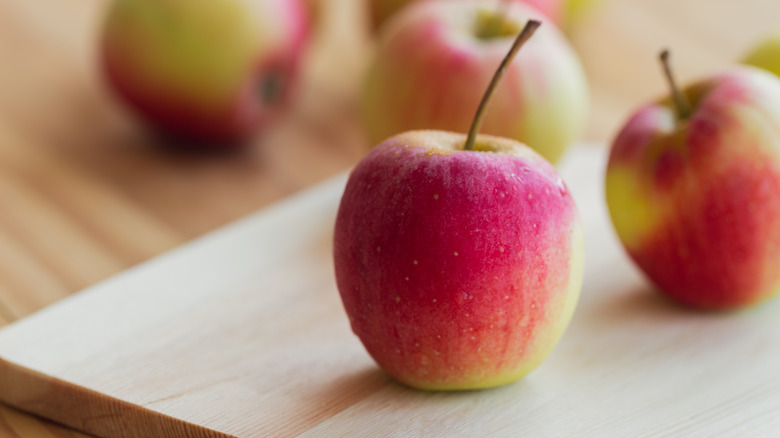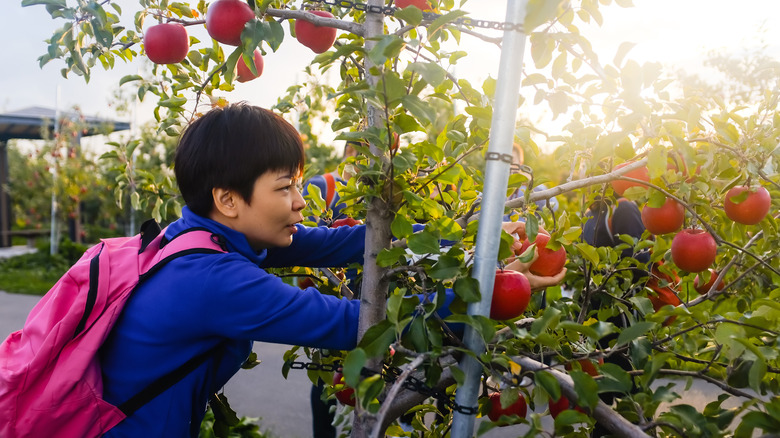What You Should Know About Japan's Aomori Apples
Japan has a dedication to fresh produce. The country takes pride in its agriculture industry, and it's not uncommon for single pieces of fruit to sell for hundreds — or even thousands — of dollars. According to one article from The Guardian, part of the reason Japanese consumers are willing to pay so much for fruit is that there is a deep-seated sense of respect and pride for the country's farmers and agricultural tradition. CNN notes that when one Japanese man paid a record-breaking $6,000 for a single watermelon in 2006, he explained that he purchased the fruit to support local farmers.
This sense of pride is strong in the Aomori prefecture, where more than half of the country's apples are produced. The website Ringo Daigaku, which translates to "Apple University," provides readers with recipes, articles, and statistics for Aomori apples. According to Japan International Broadcasting, the prefecture even boasts its own apple-themed pop group, Ringomusume, created to promote the region's agricultural industry.
But what's so special about Aomori apples?
What are Aomori apples?
The country experienced major political shifts in 1868 — leaving former samurai without jobs, as Takahisa Kudo of the Aomori Prefecture Apple Association explained to Live Japan. To combat this problem, the new government gave the samurai fruit trees and introduced them to fruit cultivation in an attempt to help them avoid unemployment.
Despite the prefecture's cold climate, which isn't suited for apple cultivation, the industry thrived. Kudo believes that this is due to the tenacity of the samurai; samurai culture was imbued with a deep sense of pride and responsibility, so failure wasn't an option.
While there is no single Aomori variety, Atlas Obscura explains that the region is known for Fuji apples, the most popular apple in Japan. Contrary to popular belief, the apple was named for the Aomori town of Fujisaki, not Mount Fuji. Fuji apples were first developed in Fujisaki in 1939 when researchers attempted to breed a better apple. World War II took a toll on the apple industry, so the new variety wasn't released to the public until 1962, but it quickly became a hit.
However, the prefecture produces a wide variety of other apples, too. According to Live Japan, these include Sekai Ichi apples, which have the distinction of being one of the largest apple varieties in the world, tart and crispy Kogyoku apples, and sweet, yellow Orin apples.
How are Aomori apples grown?
Aomori apple farmers divide the process of growing apples into 10 distinct stages (via Ringo Daigaku). In January and March, the trees are carefully pruned. Though not all apple pruning techniques are the same; the website notes that farmers in different countries tend to prune their trees in different ways.
The trees are pollinated in May, and through early summer, the farmers thin the trees out by picking and discarding small or misshapen fruit. Without the thinning process, the tree will deplete its nutrients, ensuring that none of the apples are large enough to eat.
In late summer and early fall, some farmers cover their apples with bags to extend their shelf life and stave off pests. This can be tricky because, if the bags are removed at the wrong time, the sudden exposure to sunlight can ruin the fruit.
When the trees get close to harvest, farmers prop them up with poles so the weight of the fruit doesn't break the tree. From August to November, farmers remove leaves to help expose the apples to sunlight. For maximum sun exposure, reflective sheets are placed on the ground and the apples are carefully rotated so the fruit colors evenly.
Finally, from September to November, the apples are harvested. Tokyo Weekender describes fruit markets where crates of apples are auctioned off to the highest bidder. Many of these crates are sent abroad to China, Thailand, Russia, and Vietnam, where they are sold at a premium.
How to cook with Aomori apples
Apples are a versatile ingredient: You can incorporate them into a nearly endless variety of recipes, from traditional apple pies to creative savory dishes. However, not all apple varieties are suitable for cooking. Allrecipes notes that Jonagold, Mutsu, and Fuji apples, which are all grown in Aomori prefecture (via Kyuhoshi), are among the best apples for pies, crisps, and other baked goods. Experimenting with different varieties can help you find flavors and textures that fit your personal taste.
Aomori prefecture's numerous cafes and restaurants boast dishes inspired by the region's famous apples, from apple strudels to apple gelato. According to Food and Nutrition, apple curry is even sold in Aomori prefecture — a variation on the commonly enjoyed, stew-like Japanese curry. Ringo Daigaku explains how readers can turn Aomori apples into jellies, candies, and cakes. The website even recommends incorporating them into spaghetti bolognese. And of course, Aomori apples are just as delicious when eaten raw.



